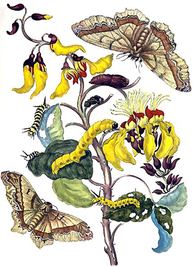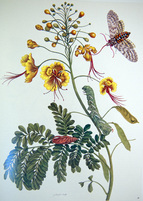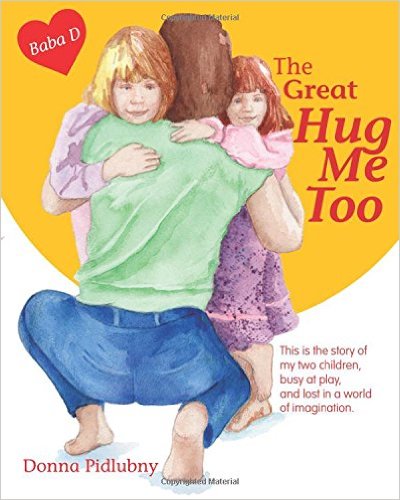
Merian's admiration for entomology led to the collection and deep study of insects as a child. She was a keen and excited observer looking to discover new knowledge. This approach yielded tremendous new information about the insect world that would later evolve into what some consider her masterpiece, Metamorphosis Insectorum Surinamensium. This work documented insects from Surinam, a Dutch Colony, in their full life cycle. It helped clarify the delicate process of metamorphosis. The work features a plate illustrating stages of Cocytius antaeus, otherwise known as the Giant Sphinx. Another example of her ability to artistically combine plants and insects is plate 52 titled citrus sinensis. In this piece, Merian illustrated a butterfly in mid landing on a branch with an orange. She had an artistic eye that could create an image of a natural habitat in motion.
Merian married an apprentice of her stepfather in 1665. His name was Johann Andreas Graff. They would eventually have two daughters, Johanna Helena and Dorothea Maria Graff. Both girls learned to paint under the tutelage of their talented parents. Merian divorced Graff in 1692 and moved with her daughters to Amsterdam. It was Amsterdam that later sponsored her trip to Surinam. What she observed there culminated in the aforementioned Metamorphosis Insectorum Surinamensium or Insects of Surinam.
Merian's work continued throughout her life, even after becoming partially paralyzed by a stroke. She died in Amsterdam in 1717, but her legacy endures. Her work is still reproduced and collected by art lovers and entomology fans alike. Merian's face was featured on the German stamp in 1987 as part of a Women in German History series. Some of her pieces can still be found on exhibit in art galleries and museums. In 2008 the Getty Center in Orange County, California featured Merian and her daughters in a 2008 exhibition to share her unique and eye-catching familial works with the world. In 2013 Google honoured Merian on what would have been her 366th birthday with a Google Doodle, a modified logo created by Google for special occasions and holidays. Today, the collections acquired by Peter the Great after Merian's death are in St.Petersburg for academic purposes.
Merian married an apprentice of her stepfather in 1665. His name was Johann Andreas Graff. They would eventually have two daughters, Johanna Helena and Dorothea Maria Graff. Both girls learned to paint under the tutelage of their talented parents. Merian divorced Graff in 1692 and moved with her daughters to Amsterdam. It was Amsterdam that later sponsored her trip to Surinam. What she observed there culminated in the aforementioned Metamorphosis Insectorum Surinamensium or Insects of Surinam.
Merian's work continued throughout her life, even after becoming partially paralyzed by a stroke. She died in Amsterdam in 1717, but her legacy endures. Her work is still reproduced and collected by art lovers and entomology fans alike. Merian's face was featured on the German stamp in 1987 as part of a Women in German History series. Some of her pieces can still be found on exhibit in art galleries and museums. In 2008 the Getty Center in Orange County, California featured Merian and her daughters in a 2008 exhibition to share her unique and eye-catching familial works with the world. In 2013 Google honoured Merian on what would have been her 366th birthday with a Google Doodle, a modified logo created by Google for special occasions and holidays. Today, the collections acquired by Peter the Great after Merian's death are in St.Petersburg for academic purposes.

When we think of flying insects, spiders, and beetles our first instinct might be to call the local pest control company to exterminate those creepy crawlers! What if we could look beyond that compulsion and make an effort to embrace what others might see? One artist in particular created enduring works of beauty from the study of entomology for the world to learn from and appreciate for centuries.
From her birth in 1647, artist Maria Sibylla Merian's future could appear predetermined. She was born in Frankfurt into the family of Matthaus Merian, a Swiss engraver and publisher. Sadly, when Merian was just three years old her father passed away. As fate would have it, she didn't have to look far to find a new mentor. Her mother soon married Jacob Marrel, an artist and art dealer. Marrel was trained by still life artist Georg Flegel. With so much talent to guide her it is no surprise that by age 28 she had already published her first book of natural illustrations titled Neues Blumenbuch. This publication contained colorful and detailed floral engravings. It was unique for its time because the engravings are not simply individual flowers. As a pioneering entomologist who didn't shy away from observing bugs up close, she combined foliage with various insects such as butterflies, worms, and other creepy crawlers that come to mind. Her combination of self-taught knowledge and artistic talent allowed for a more organic result in her engravings. Her scientifically accurate detail garnered respect and credibility in the world of entomology and is still revered today.
From her birth in 1647, artist Maria Sibylla Merian's future could appear predetermined. She was born in Frankfurt into the family of Matthaus Merian, a Swiss engraver and publisher. Sadly, when Merian was just three years old her father passed away. As fate would have it, she didn't have to look far to find a new mentor. Her mother soon married Jacob Marrel, an artist and art dealer. Marrel was trained by still life artist Georg Flegel. With so much talent to guide her it is no surprise that by age 28 she had already published her first book of natural illustrations titled Neues Blumenbuch. This publication contained colorful and detailed floral engravings. It was unique for its time because the engravings are not simply individual flowers. As a pioneering entomologist who didn't shy away from observing bugs up close, she combined foliage with various insects such as butterflies, worms, and other creepy crawlers that come to mind. Her combination of self-taught knowledge and artistic talent allowed for a more organic result in her engravings. Her scientifically accurate detail garnered respect and credibility in the world of entomology and is still revered today.



 RSS Feed
RSS Feed